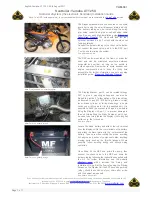
Haklift Oy
Asessorinkatu 3-7
20780 Kaarina, Finland
Tel. +358 2 511 5511
sales@haklift.com
www.haklift.com
Lifting Solutions Group
Axel Johnson International
•
DO NOT
use a snatch block without a visible marking of the lifting capacity
•
DO NOT
use modified or deformed hooks/shackles
•
DO NOT
perform any modifications to the snatch block (no welding, unauthorized spare parts etc.)
•
DO NOT
attempt any lifting or pulling operation unless you have been trained in the use of the
equipment concerned
•
Visually check the snatch block daily before use
–
DO NOT
use if any defect is found
•
Make sure the length of the rope is long enough for the intended work
•
Make sure the carrying rope is clean and undamaged
•
Make sure the carrying rope is firmly fastened to the snatch block
•
Make sure the load (fastening point) is properly seated in the shackle/hook and the fit is adequate
•
Hook has a spring-loaded safety latch; shackle has a load bearing bolt, nut and safety cotter pin
–
these must be properly secured and functioning
•
DO NOT
hitch the load on the hook tip
When in use
•
Make sure the rope enters the sheave in a straight line,
NOT
from an angle, it will wear the sheave/rope
•
DO NOT
continue using the snatch block if the rope is fouled or damaged
•
DO NOT
use the snatch block for anchoring loads
•
DO NOT
allow swinging of the load, causing impacts or vibrations
•
DO NOT
pull the rope over any edge
•
DO NOT
weld, cut or make other operations on a suspended load
•
Pay attention to the limit positions,
DO
NOT
subject the shackle/hook or frame to bending forces
•
Be careful
NOT
to put fingers or other body parts between moving components of the system
MAINTENANCE & STORAGE
•
Enable qualified personnel to inspect the snatch block regularly
•
Ensure that the carrying rope is clean and undamaged
•
Ensure that relevant moving/sliding parts are greased enough (notice the grease nipples, if the model
in question has ones)
A thorough inspection should be carried out and documented by a qualified person at least once a year or
more frequent if required by legislation or working conditions. Inspections should be executed to a properly
cleaned product, in a good light and observing all the relevant structural components.
Store snatch blocks in a dry, clean and cool place free from direct sunlight. Avoid areas where heat, moisture,
light, oil, and chemicals or their vapors or other degrading elements may be present.
•
Always store the snatch block without any suspended load
•
Remove all dust, damp and impurities from the snatch block
•
Lubricate the pulle
y’s main axle, swivel, pivot of the hook and spring of the hook’s safety latch



























